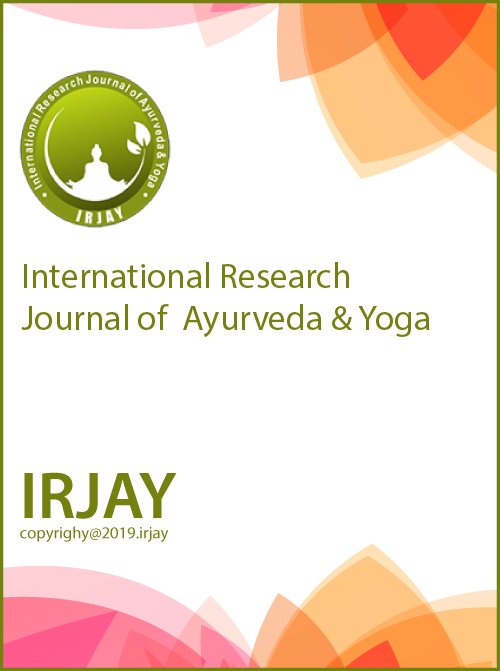Impact of Mandukasana and Dhanurasana Practice during Brahmamuhurta on Diabetes Mellitus
DOI:
https://doi.org/10.48165/IRJAY.2023.6909Keywords:
Brahma muhurta, Dhanurasana, Diabetes, MandukasanaAbstract
Introduction: Diabetes mellitus is a non-communicable disease spreading rapidly in the entire world due to disturbance in an individual’s lifestyle. Ayurveda is a rational science of life as it has a great contribution in the prevention of diseases. In classical texts, Dincharya upkram had been described foremost to make people aware about health and personal hygiene. Waking up at Brahma muhurta and utilizing that time in yoga and meditation makes man healthy and free from diseases. Practicing yoga such as Mandukasana and Dhanurasana during brahma muhurta can help to achieve health and one can get rid of the metabolic disorder diabetes mellitus. Aim: Th aim of the study was to review the impact of Mandukasana and Dhanurasana practice during Brahma muhurta on diabetes mellitus. Materials and Methods: Critical review from the Literature from Ayurvedic texts, Yoga texts, research articles related to the topic is referred. Observation and Results: Review of literature and research articles on Mandukasana and Dhanurasana shows that regular practice of Mandukasana and Dhanurasana can reduce insulin resistance and increase insulin sensitivity. Thus, asanas such as Mandukasana and Dhanurasana maintain the function of pancreas and reduce the blood glucose level in diabetic patients. Conclusion: Regularly practicing Mandukasana and Dhanurasana can improve the blood supply to the abdominal organs which includes pancreas too. This leads to getting rid of metabolic disorder and diabetes mellitus and improves the quality of life of an individual.
Downloads
References
Acharya YT. Charaka, Charak Samhita with Ayurveda Dipika Commentary of Chakrapani Datta. Varanasi: Chaukhamba Orientalia; 2011. p. 187.
Tewari PV. Vagbhata, Astanga Hridyam with Sarvanga Sunder Commentary Sutrasthana. 2nd ed., Ch. 2. Verse 1. Varanasi: Chaukhamba Orientalia; 2002. p. 16.
Tewari PV. Vagbhata, Astanga Hridyam with Sarvanga Sunder Commentary by Arunadatta. 10th ed. Varanasi: Chaukhamba Orientalia; 2011. p. 24.
Tewari PV. Vagbhata, Astanga Hridyam with Sarvanga Sunder Commentary by Arunadatta. 10th ed. Varanasi: Chaukhamba Orientalia; 2011. p. 25.
Tewari PV. Vagbhata, Astanga Hridyam with Sarvanga Sunder Commentary by Arunadatta. 10th ed. Varanasi: Chaukhamba Orientalia; 2011. p. 26.
Tewari PV. Vagbhata, Astanga hridyam with Sarvanga Sunder Commentary by Arunadatta. 10th ed. Varanasi: Chaukhamba Orientalia; 2011. p. 27.
Bijlani RL. Understanding Medical Physiology. 4th ed. New Delhi: Jaypee Brothers Medical Publication; 2011. p. 751.
Tewari PV. In: Upadhyaya VY, editor. Vagbhata, Astangahridyam with Vidyotini Hindi Commentary by Kaviraj Atridev Gupta. Verse 2/1. Varanasi: Chaukhamba Orientalia; 2011.
Available from: https:/en wikepedia.org/wiki/brahmamuhurta [Last assessed on 2023 May 05].
Acharya YT. Agnivesha, Charak, Dridhabala, Charak Samhita. 2nd ed. Vimansthana 8/7. Varanasi: Chaukhamba Orientaia; 1990. 11. Gupta A. In: Upadhyaya VY, editor. Vagbhata, Astangahridyam with
Vidyotini Hindi Commentary by Kaviraj Atridev Gupta. Varanasi: Chaukhamba Orientalia; 2011.
Changani SG. Astangasangraha edited with Arthaprakashika. Verse 3/3. Varanasi: Chaukhamba Sanskrit Sansthan; 2005.
Mohan H. Text Book of Pathology. 6th ed. New Delhi: Jaypee Publishers; 2010. p. 818.
Acharya YT. Susruta, Susruta Samhita with Nibhandhasangraha Commentary of Dalhana. Varanasi: Chaukhamba Orientalia; 2009. p. 289.
Tiwari PV. Vagbhata, Astanga Hridyam with Sarvanga Sunder Commentary by Arunadatta. 10th ed. Varanasi: Chaukhamba Orientalia; 2011. p. 502.
Malhotra V, Singh S. The beneficial effect of yoga in Diabetes. Nepal Med Coll J 2005;7:145-7.
Uma YM, Pratibha K, Chiplunkar S. A review on impact of brahma muhurta on attitude of yoga in the lifestyle disorders-Diabetes mellitus. Int J Yoga Allied Sci 2013;2:152-5.
Menaria R, Singh H, Tank P, Menaria J. Prophylactic role of Mandukasana and OM chanting on Patients who survives with diabetes. J Drug Deliv Ther 2021;11:5-7.

